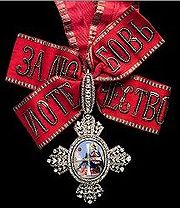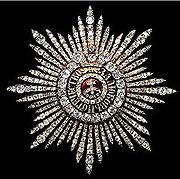
Order of St Catherine
Encyclopedia


Instituted on November 24, 1714 by Peter the Great on the occasion of his marriage to Catherine I of Russia
Catherine I of Russia
Catherine I , the second wife of Peter the Great, reigned as Empress of Russia from 1725 until her death.-Life as a peasant woman:The life of Catherine I was said by Voltaire to be nearly as extraordinary as that of Peter the Great himself. There are no documents that confirm her origins. Born on...
. For the majority of the time of Imperial Russia, it was the only award for ladies** (the Order of Saint Olga
Order of Saint Olga
The Order of Saint Olga existed briefly as a decoration for women from 1916 to 1917. It was awarded by the Russian Tsar only to women, but ceased with the fall of the Romanov dynasty....
existed briefly from 1916–1917, but ceased with the fall of the Romanov dynasty).
The statutes of the Order were first published in 1713, and the order was under the patronage of St. Catherine of Alexandria, the patron saint
Patron saint
A patron saint is a saint who is regarded as the intercessor and advocate in heaven of a nation, place, craft, activity, class, clan, family, or person...
of the Empress. On the 24th of November 1714, on the Empress' name day
Name day
A name day is a tradition in many countries in Europe and Latin America that consists of celebrating the day of the year associated with one's given name....
, Peter the Great personally bestowed the insignia of the Order upon the Empress Catherine, creating her Grand Mistress
Grand Master (order)
Grand Master is the typical title of the supreme head of various orders of knighthood, including various military orders, religious orders and civil orders such as the Ancient Order of Hibernians and the Orange Order...
of the Order. However, no further members were inducted until 1726.
Classes
The award was bestowed in two classes:- Dame Grand Cross (entitled to both the Badge and the Star)
- Dame Lesser Cross (entitled to the Badge)
Insignia
- A Riband (sash) of scarletScarlet (color)Scarlet is a bright red color with a hue that is somewhat toward the orange. It is redder than vermilion. It is a pure chroma on the color wheel one-fourth of the way between red and orange. Scarlet is sometimes used as the color of flame...
moiré with silver edges embroidered with the inscription: "ZA LYUBOV' I OTECHESTVO" ("ЗА ЛЮБОВЬ И ОТЕЧЕСТВО" – "For the Love and the Fatherland").
- The Badge (or Jewel) of the Order consisted of a cross with a large medallion set in the center of it. On the medallion was depicted the order's patron saint, Catherine of Alexandria, holding a large white cross, the symbol of her martyrdom. In the four quadrants formed by the cross are written the initials, "D.S.F.R." (Domine Salvum Fac Regem, God Save the Tsar). The Badge was attached to the Riband. On the obverse is an image of eagles destroying a nest of snakes at the foot of a ruined tower, at the top of which is a nest of eaglets. Above is the motto Aequant Munia Comparis ("By her works she is to her husband compared").
- The Star (or Plaque) consisted of a medallion set on a silver, eight-pointed star with rays, encrusted with diamonds. On the red medallion in the center is depicted the wheelWheelA wheel is a device that allows heavy objects to be moved easily through rotating on an axle through its center, facilitating movement or transportation while supporting a load, or performing labor in machines. Common examples found in transport applications. A wheel, together with an axle,...
of St. Catherine (symbol of her martyrdom) surmounted by a cross. Encircling the medallion is the motto of the order (the same as on the Riband).
Membership
Every Russian Grand Duchess was conferred the Grand Cross of the Order at her christeningInfant baptism
Infant baptism is the practice of baptising infants or young children. In theological discussions, the practice is sometimes referred to as paedobaptism or pedobaptism from the Greek pais meaning "child." The practice is sometimes contrasted with what is called "believer's baptism", or...
(or marriage into the Romanov family), and Princess
Princess
Princess is the feminine form of prince . Most often, the term has been used for the consort of a prince, or his daughters....
es of the Imperial Blood were invested upon attaining their majority at 18.
In addition to the royal members, a fixed number (106) of other members were permitted by the statutes:
- 12 Dames Grand Cross
- 94 Dames Small Cross
The twelve Dames Grand Cross were typically female members of foreign Ruling Houses. Queen Alexandra of Great Britain
Great Britain
Great Britain or Britain is an island situated to the northwest of Continental Europe. It is the ninth largest island in the world, and the largest European island, as well as the largest of the British Isles...
was made a Dame Grand Cross of the Order of Saint Catherine by Alexander II, Princess Alice of Greece
Princess Alice of Battenberg
Princess Alice of Battenberg, later Princess Andrew of Greece and Denmark was the mother of Prince Philip, Duke of Edinburgh, and mother-in-law of Elizabeth II....
(Prince Phillip's mother) was also a member of the Order.
The only known award of the order to a male was in 1727 prince Alexandre Menshikov, best friend of tzar Peter I of Russia
Peter I of Russia
Peter the Great, Peter I or Pyotr Alexeyevich Romanov Dates indicated by the letters "O.S." are Old Style. All other dates in this article are New Style. ruled the Tsardom of Russia and later the Russian Empire from until his death, jointly ruling before 1696 with his half-brother, Ivan V...
.
The Order of St Catherine being the only award they were entitled to give without the presence or permission of the Tsar or Tsarina, who were supposed dead.
The Dames Small Cross were all women of the highest nobility
Nobility
Nobility is a social class which possesses more acknowledged privileges or eminence than members of most other classes in a society, membership therein typically being hereditary. The privileges associated with nobility may constitute substantial advantages over or relative to non-nobles, or may be...
, who were part of the Suite of the Empress and had engaged in important philanthropic or charitable works outside of their duties at Court.
Annual function
The Order of Saint Catherine's annual function (compare Garter service in England) was held on November 24 (December 7 on the Gregorian CalendarGregorian calendar
The Gregorian calendar, also known as the Western calendar, or Christian calendar, is the internationally accepted civil calendar. It was introduced by Pope Gregory XIII, after whom the calendar was named, by a decree signed on 24 February 1582, a papal bull known by its opening words Inter...
), the feast day of Saint Catherine of Alexandria. The Order met for a celebration of the Divine Liturgy
Divine Liturgy
Divine Liturgy is the common term for the Eucharistic service of the Byzantine tradition of Christian liturgy. As such, it is used in the Eastern Orthodox and Eastern Catholic Churches. Armenian Christians, both of the Armenian Apostolic Church and of the Armenian Catholic Church, use the same term...
. Then, wearing the robes and the insignia of the Order, the women of the Imperial Family, followed by the 106 Dames Grand and Small Cross would go in procession from the Imperial Chapel to a banqueting hall specially prepared for the occasion. The Hall of Saint Catherine in the Great Kremlin Palace in Moscow
Moscow
Moscow is the capital, the most populous city, and the most populous federal subject of Russia. The city is a major political, economic, cultural, scientific, religious, financial, educational, and transportation centre of Russia and the continent...
was used for these Occasions. The coloring and decoration of the Hall incorporate those of the Order. The Hall also served as the throne room
Throne room
A throne room is the room, often rather a hall, in the official residence of the crown, either a palace or a fortified castle, where the throne of a senior figure is set up with elaborate pomp— usually raised, often with steps, and under a canopy, both of which are part of the original notion of...
for the Empress Consort. To this day, in the Russian Federation uses this room to receive foreign dignitaries.
Other Orders of St. Catherine
- An Order of Saint Catherine was founded by Humbert IIHumbert II of ViennoisHumbert II de la Tour-du-Pin was the Dauphin of the Viennois from 1333 to 16 July 1349. He was a son of the Dauphin John II and Beatrice of Hungary...
, Dauphin du Viennois ca. 1335 - The Knights of Saint Catherine of Mount Sinai, an honorific insignia bestowed upon knightKnightA knight was a member of a class of lower nobility in the High Middle Ages.By the Late Middle Ages, the rank had become associated with the ideals of chivalry, a code of conduct for the perfect courtly Christian warrior....
s who made a pilgrimagePilgrimageA pilgrimage is a journey or search of great moral or spiritual significance. Typically, it is a journey to a shrine or other location of importance to a person's beliefs and faith...
to the St. Catherine's Monastery on Mount SinaiMount SinaiMount Sinai , also known as Mount Horeb, Mount Musa, Gabal Musa , Jabal Musa meaning "Moses' Mountain", is a mountain near Saint Catherine in the Sinai Peninsula of Egypt. A mountain called Mount Sinai is mentioned many times in the Book of Exodus in the Torah and the Bible as well as the Quran...
from the 11th to the 15th centuries.

